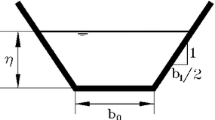Abstract
The parameters of the shock adiabat of a porous material are calculated in the mesoscopic setting with the developed method of a moving window. The porous material is considered a framework of solid material that fills the space between pores, the mechanical properties and shock adiabat of which are often well known. The essence of the method is as follows: uncompressed material flows into the computational box with a constant velocity, while the outflow velocity from the box is chosen based on iterations so as to make the wave front immobile relative to the window, because the stationary mode of shock-wave propagation must be achieved to calculate the shock adiabats. The simulation of shock waves is performed both in the standard setting with an immobile piston (inverse-motion method) and in the system of a moving window. It is demonstrated that the wave profiles obtained with both methods are identical after the stationary mode is achieved. As an example, the shock adiabats of porous copper, which adequately reproduce experimental data for different porosities, are calculated. The proposed mesoscopic method of calculating the response of porous materials to shock compression in a moving window enables direct calculation of desired shock adiabats for porous materials that have not been studied experimentally.







Similar content being viewed by others
REFERENCES
Medin, S.A. and Parshikov, A.N., Math. Models Comput. Simul., 2014, vol. 6, no. 1, p. 42.
Mader, C.L. and Kershner, J.D., The three-dimenional hydrodynamic hotspot model, Tech. Rep. Los Alamos National Laboratory, Los Alamos, 1981.
Zhao, F.P., Wu, H., and Luo, S.-N., J. Appl. Phys., 2013, vol. 114, 073501.
Mi, X., Michael, L., Nikiforakis, N., and Higgins, A.J., J. Appl. Phys., 2019, vol. 125, 245901.
Lastiwka, M., Basa, M., and Quinlan, N.J., Int. J. Numer. Methods Fluids, 2009, vol. 61, no. 7, p. 709.
Federico, I., Marrone, S., Colagrossi, A., Aristodemo, F., and Antuono, M., Eur. J. Mech., B, 2012, vol. 34, p. 35.
Sun, P.-N., Colagrossi, A., and Zhang, A., Theor. Appl. Mech. Lett., 2018, vol. 8, no. 2, p. 115.
Alvarado-Rodriguez, C., Klapp, J., Sigalotti, L., Dominguez, J., and Sanchez, E., Comput. Fluids, 2017, vol. 159, p. 177.
Ferrand, M., Joly, A., Kassiotis, C., Violeau, D., Leroy, A., Morel, F.-X., and Rogers, B.D., Comput. Phys. Commun., 2016, vol. 210, p. 29.
Ferrand, M., Laurence, D.R., Rogers, B.D., Violeau, D., and Kassiotis, C., Int. J. Numer. Methods Fluids, 2012, vol. 71, no. 4, p. 446.
Hirschler, M., Kunz, P., Huber, M., Hahn, F., and Nieken, U., J. Comput. Phys., 2016, vol. 307, p. 614.
Kunz, P., Hirschler, M., Huber, M., and Nieken, U., J. Comput. Phys., 2016, vol. 326, p. 171.
Monteleone, A., Monteforte, M., and Napoli, E., Comput. Fluids, 2017, vol. 159, p. 9.
Zhakhovskii, V.V., Zybin, S.V., Nishihara, K., and Anisimov, S.I., Phys. Rev. Lett., 1999, vol. 83, p. 1175.
Egorova, M.S., Dyachkov, S.A., Parshikov, A.N., and Zhakhovsky, V.V., Comput. Phys. Commun., 2019, vol. 234, p. 112.
Parshikov, A.N. and Medin, S.A., J. Comput. Phys., 2002, vol. 180, p. 358.
Medin, S.A. and Parshikov, A.N., High Temp., 2010, vol. 48, no. 6, p. 926.
Alder, B.J., Fernbach, S., and Rotenberg, M., Fundamental Methods in Hydrodynamics, New York: Acade-mic, 1964.
Dyachkov, S.A., Parshikov, A.N., and Zhakhovsky, V.V., J. Phys.: Conf. Ser., 2017, vol. 815, 012012.
Takeda, H., Miyama, S.M., and Sekiya, M., Prog. Theor. Phys., 1994, vol. 92, no. 5, p. 939.
Marsh, S.P., LASL Shock Hugoniot Data, Los Alamos: Los Alamos Natl. Lab., 1980.
Murzov, S.A., Dyachkov, S.A., Egorova, M.S., Parshikov, A.N., and Zhakhovsky, V.V., J. Phys.: Conf. Ser., 2019, vol. 1147, 012041.
Trunin, R.F., Medvedev, A.B., Funtikov, A.I., Podurets, M.A., Simakov, G.V., and Sevast’yanov, A.G., Zh. Eksp. Teor. Fiz., 1989, vol. 95, no. 2, p. 631.
Wilkinson, S.D., Braithwaite, M., Nikiforakis, N., and Michael, L., J. Appl. Phys., 2017, vol. 122, 225112.
Zel’dovich, Ya.B. and Raizer, Yu.P., Fizika udarnykh voln i vysokotemperaturnykh gidrodinamicheskikh yavlenii. Prakticheskoe posobie (Physics of Shock Waves and High-Temperature Hydrodynamic Phenomena: Practical Guide), Moscow Fizmatlit, 2008.
Funding
This study was supported by the Russian Science Foundation (project no. 19-19-00697).
Author information
Authors and Affiliations
Corresponding author
Additional information
Translated by A. Sin’kov
Rights and permissions
About this article
Cite this article
Murzov, S.A., Parshikov, A.N., D’yachkov, S.A. et al. Simulation of Stationary Shock Waves in Porous Copper with Smoothed Particle Hydrodynamics. High Temp 59, 230–239 (2021). https://doi.org/10.1134/S0018151X21020097
Received:
Revised:
Accepted:
Published:
Issue Date:
DOI: https://doi.org/10.1134/S0018151X21020097




